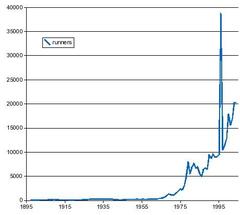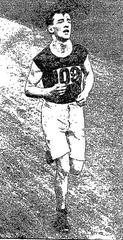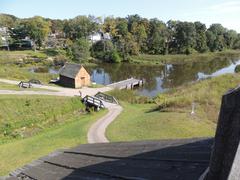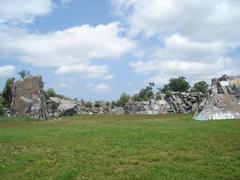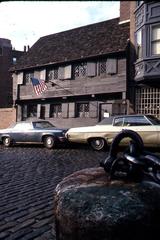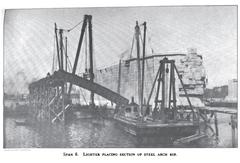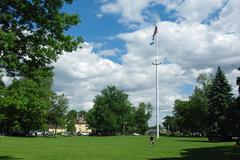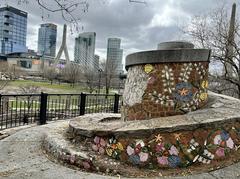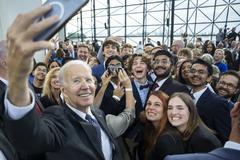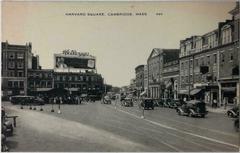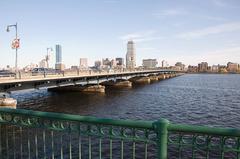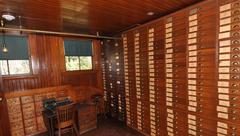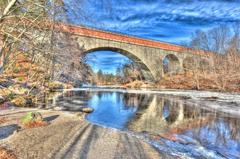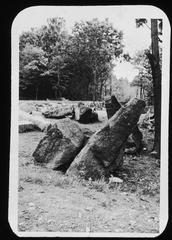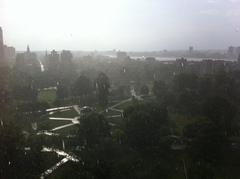
Prudential Tower Visiting Hours, Tickets, and Historical Sites in Boston
Date: 19/07/2024
Introduction
The Prudential Tower, affectionately known as the ‘Pru,’ is a defining feature of Boston’s skyline, located in the vibrant Back Bay neighborhood. Completed in 1964, it was designed by the architectural firm Charles Luckman and Associates and stands at 749 feet (228 meters), making it the second tallest building in Boston. The tower’s inception was part of the Prudential Center complex, a significant urban renewal project initiated by the Prudential Insurance Company of America. The Prudential Tower exemplifies the International Style of architecture, characterized by its clean lines, functional form, and minimalist aesthetic. Over the decades, it has not only served as a commercial hub but also as a cultural landmark, attracting millions of visitors to its Skywalk Observatory for panoramic views of the city. This comprehensive guide delves into the rich history, architectural marvels, and cultural significance of the Prudential Tower, while also providing essential visitor information to enhance your experience. Whether you’re a local or a tourist, this guide aims to offer valuable insights into one of Boston’s most iconic landmarks (Boston Skyscrapers, ArchDaily).
Table of Contents
- Introduction
- History of Prudential Tower, Boston
- Role in Urban Development
- Cultural Impact
- Renovations and Modernization
- Visitor Information
- Historical Events and Milestones
- Ownership and Management
- Legacy and Future Prospects
- FAQ
- Conclusion
- Visuals and Media
History of Prudential Tower, Boston
Construction and Early Years
The Prudential Tower, often referred to as the ‘Pru,’ is an iconic skyscraper located in the Back Bay neighborhood of Boston, Massachusetts. The tower was conceived as part of the Prudential Center complex, a major urban renewal project initiated by the Prudential Insurance Company of America. Construction began in 1960 and was completed in 1964. Designed by the architectural firm Charles Luckman and Associates, the tower stands at 749 feet (228 meters) and was the tallest building in Boston until the completion of the John Hancock Tower in 1976 (Boston Skyscrapers).
Architectural Significance
The Prudential Tower is a prime example of the International Style of architecture, characterized by its clean lines, functional form, and lack of ornamentation. The building’s facade is composed of aluminum and glass, giving it a sleek, modern appearance. The tower’s design was influenced by the architectural trends of the mid-20th century, which emphasized simplicity and efficiency. The building’s structural system consists of a steel frame with a concrete core, allowing for large, open floor plans that were ideal for office use (ArchDaily).
Role in Urban Development
The construction of the Prudential Tower marked a significant moment in Boston’s urban development. At the time, the Back Bay area was undergoing a transformation from a predominantly residential neighborhood to a bustling commercial district. The Prudential Center complex, which includes the tower, shopping mall, and other office buildings, played a crucial role in this transformation. The development provided much-needed office space and retail opportunities, attracting businesses and visitors to the area (Boston Planning & Development Agency).
Cultural Impact
Over the years, the Prudential Tower has become a cultural landmark in Boston. Its observation deck, known as the Skywalk Observatory, offers panoramic views of the city and has been a popular tourist attraction since its opening. The tower has also been featured in various films, television shows, and literature, further cementing its status as an iconic symbol of Boston. The building’s annual lighting events, such as the holiday lights display, have become cherished traditions for both locals and visitors (Boston.com).
Renovations and Modernization
In the decades following its completion, the Prudential Tower has undergone several renovations to modernize its facilities and improve energy efficiency. In the early 2000s, the building’s mechanical systems were upgraded, and the facade was cleaned and restored. More recently, the tower has been retrofitted with energy-efficient lighting and HVAC systems, earning it a LEED Gold certification for sustainability. These efforts have ensured that the Prudential Tower remains a state-of-the-art office building while preserving its historical significance (US Green Building Council).
Visitor Information
Visiting Hours and Tickets
The Skywalk Observatory is open daily from 10 a.m. to 8 p.m. Ticket prices are $20 for adults, $15 for seniors and students, and $10 for children under 12. Tickets can be purchased online or at the entrance.
Travel Tips and Nearby Attractions
The Prudential Tower is easily accessible by public transportation, with the Prudential Center stop on the Green Line being the closest. Nearby attractions include the Boston Public Library, Copley Square, and Newbury Street, making it easy to plan a full day of sightseeing.
Accessibility
The Prudential Tower is fully accessible, with elevators and ramps available for visitors with mobility impairments.
Historical Events and Milestones
The Prudential Tower has been the site of numerous historical events and milestones. In 1971, the building hosted the first Boston Marathon wheelchair race, an event that has since become a staple of the annual marathon. In 2004, the tower was illuminated in red, white, and blue to commemorate the Boston Red Sox’s World Series victory, a momentous occasion for the city. The building has also been a focal point for various social and political demonstrations, reflecting its importance as a public space in Boston (Boston Marathon History).
Ownership and Management
Since its completion, the Prudential Tower has changed ownership several times. Originally owned by the Prudential Insurance Company, the building was sold to Boston Properties in 1998. Boston Properties, a prominent real estate investment trust, has managed the tower and the surrounding Prudential Center complex, ensuring its continued success as a premier office and retail destination. The company’s stewardship has included significant investments in maintenance and upgrades, preserving the tower’s status as a key asset in Boston’s commercial real estate market (Boston Properties).
Legacy and Future Prospects
As the Prudential Tower approaches its 60th anniversary, its legacy as a pioneering skyscraper and cultural icon remains strong. The building’s innovative design and role in Boston’s urban development have left an indelible mark on the city’s skyline. Looking ahead, the Prudential Tower is poised to continue its legacy of excellence, with ongoing investments in sustainability and modernization ensuring that it remains a vital part of Boston’s architectural and cultural heritage (Boston Globe).
FAQ
What are the visiting hours for Prudential Tower?
The Skywalk Observatory is open daily from 10 a.m. to 8 p.m.
How much are tickets to the Prudential Tower Skywalk Observatory?
Tickets are $20 for adults, $15 for seniors and students, and $10 for children under 12.
Is the Prudential Tower accessible?
Yes, the Prudential Tower is fully accessible with elevators and ramps available.
Conclusion
In summary, the Prudential Tower’s history is a testament to its architectural significance, cultural impact, and enduring legacy. From its construction in the early 1960s to its current status as a modern, sustainable office building, the tower has played a pivotal role in shaping Boston’s urban landscape and continues to be a beloved landmark for residents and visitors alike. To stay updated and learn more about other historical sites in Boston, download our mobile app Audiala and follow us on social media.
Visuals and Media
Alt Text - Prudential Tower in Boston at dusk
For a virtual tour of the Prudential Tower, visit our website.
References
- Boston Skyscrapers. (n.d.). Retrieved from Boston Skyscrapers
- ArchDaily. (n.d.). Retrieved from ArchDaily
- Boston Planning & Development Agency. (n.d.). Retrieved from Boston Planning & Development Agency
- Boston.com. (n.d.). Retrieved from Boston.com
- US Green Building Council. (n.d.). Retrieved from US Green Building Council
- Boston Marathon History. (n.d.). Retrieved from Boston Marathon History
- Boston Properties. (n.d.). Retrieved from Boston Properties
- Boston Globe. (n.d.). Retrieved from Boston Globe


